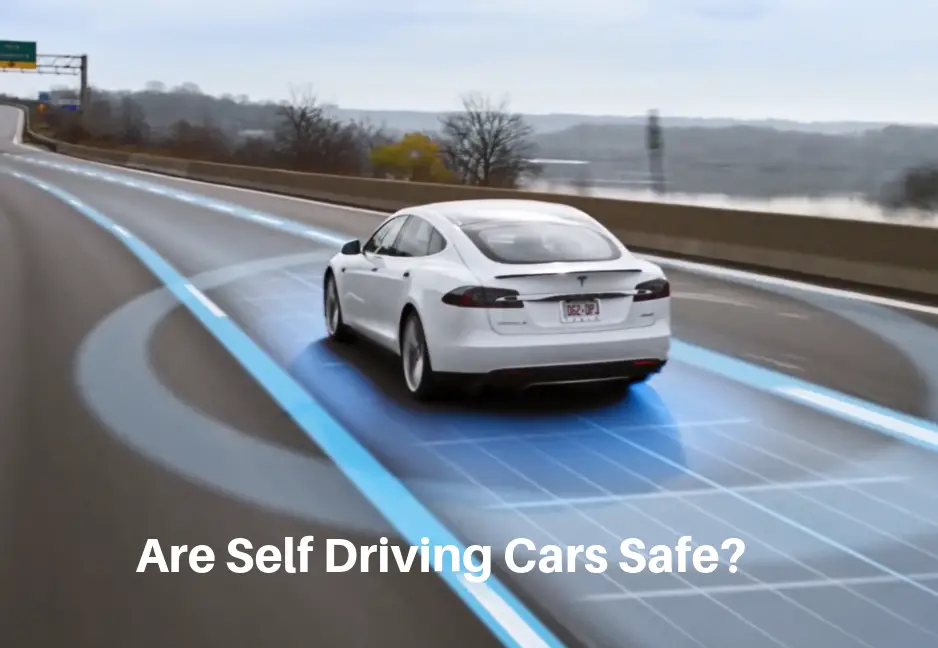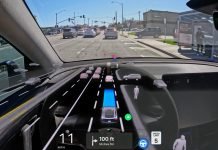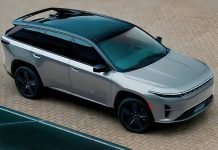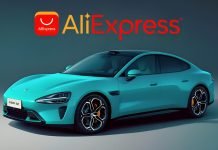Tesla’s Autopilot feature which is mainly meant for highway driving is the most advanced computer-controlled driving system available to consumers right now. Like other autonomous driving systems, it combines a bunch of different pieces of technology to let the car collect and process information kind of like a human would and drive itself.

Are Self Driving Cars Safe? Are They Safer than Humans? Pros and Cons
Are Self Driving Cars Safe?
A GPS system gives the car information about things like where it is and the speed limit. A camera on the front of the rear-view mirror and a continental radar sensor on the front grille can scan about 160 meters of the road ahead of the car. There are also 12 ultrasonic sensors that send out pulses and measure how they navigate to map out the 8 meters around the car.

The car’s computer sorts through all the data from the camera and sensors, keeping track of the information it needs to navigate the road lane markers, roadside barriers and the movement patterns of other vehicles. Then, it carefully guides or manipulates the car down the road, watching out for any sudden changes nearby. If a truck in front of the car stops suddenly, for example, the computer will stop the car, as well.
Are Self Driving Cars Safer Than Humans?
Tesla says that Autopilot is in a public beta test, meaning that the feature is still experimental and users are helping catch any bugs or other problems. The driver is supposed to have their hands on the steering wheel at all times, ready to take control of the car if need be. If the system detects that a driver doesn’t have their hands on the wheel, it’ll beep and show multiple warnings, and eventually stop the car. Having an alert driver is really important because there are a lot of conditions where Autopilot can’t work safely.
For example, the car’s camera might not be able to see the lane markings on the road if it is snowing. Even driving up a hill can block the camera’s view. In those cases, where the computer realizes that it can’t accurately keep track of everything around it, it’ll turn Autopilot off and tell the driver to take control of the car. Other times, the computer just doesn’t react to sudden changes on the road the way that it should.
Are Self Driving Cars Safe, Pros and Cons?
Pros
Computers do have advantages over humans when it comes to this stuff: they can constantly monitor every direction without getting distracted or tired, and their response times can be much faster than our reflexes.
Cons
Lack of Decision-making skills. The people have their own advantages too. We have really good sensory perception and decision-making skills that are far more advanced than any computer program.
According to Tesla, this is the first fatality in over 1 billion miles that users have driven with Autopilot mode enabled, while with human drivers, on average there’s a fatal car accident for every 150 million kilometers driven. Honestly, this isn’t a valid comparison, Teslas are very safe cars with advanced safety systems, so they’re bound to have fewer deaths per passenger mile with Autopilot on or off. The average car on American roads is more than 10 years old and so are its safety features. And, of course, a sample size of one is pretty statistically useless. Even so, it’s clear that even at this very early stage computer-driven cars seem pretty good at their jobs. But self-driving car systems, of course, aren’t anywhere close to perfect and Tesla is open about Autopilot’s limitations.
Tesla Autopilot Accident
Now Let’s talk about the incident A May 7, 2016 crash in Williston, Florida. where the Autopilot failed to see a turning tractor-trailer. A driver was killed while his car was doing most of the driving for him – in this case, a Tesla Model S with its Autopilot mode enabled. The fact that there haven’t been any fatalities until now is a testament to the technology behind self-driving cars.
But this crash is a reminder that this technology has its limitations. Investigators from the National Highway Traffic Safety Administration are still piecing together the details of the accident, but they do know the basics: The driver, Joshua Brown, had his car’s Autopilot mode activated while driving down a highway in Florida.
When a tractor-trailer made a left turn in front of the car, the car didn’t stop – it went under the trailer, then hit a fence and a power pole. Brown was killed, and Autopilot didn’t save him. When humans drive cars, we’re following the road, keeping track of people, bikes, and other cars, and looking out for any sudden changes that might mean we have to swerve or stop to avoid an accident.
When the tractor-trailer (which was white) turned left in front of the car, the computer couldn’t see it against the bright sky, so it didn’t hit the brakes and neither did Brown. One of the chief concerns with this Autopilot isn’t technological, it’s psychological. If you believe your Autopilot system is going to save you, you might not worry so much about being distracted. An aftermarket DVD player was found in Brown’s Tesla.
Whether he was watching it at the time of the crash is unknown, but that is the kind of behavior that an Autopilot system might encourage whether or not it’s expressly forbidden. More research needs to be done to make these systems better, but also on how they affect driver behavior, and how to ensure that drivers are using them properly. Either way, Brown’s death wasn’t Autopilot’s fault.
The system didn’t cause an accident by driving dangerously. The driver and Autopilot both failed to detect a sudden change and prevent a crash. In some ways, the software has, for years been a matter of life and death, but never so much as with self-driving cars. They have a good track record and the technology will keep improving. But their human driving partners are a necessary part of the safety of these systems, and that’s going to be the case for quite a long time.
FAQs
Are Self-Driving Cars Safe for Humans?
The safety of self-driving cars is a topic of ongoing research and development. While autonomous vehicle technology has the potential to enhance road safety by eliminating human error, there are still challenges and concerns to address before widespread adoption. Self-driving cars utilize a combination of sensors, cameras, and algorithms to perceive and navigate the environment. Companies investing in autonomous technology prioritize safety as a fundamental aspect of their development process.
However, there have been incidents involving self-driving cars, highlighting the need for continued refinement and testing. Ethical considerations, technical limitations, and ensuring reliable performance in complex and unpredictable situations are among the challenges faced in ensuring the safety of self-driving cars.
Regulatory bodies and organizations are actively working to establish guidelines and standards for autonomous vehicles. Ultimately, the goal is to achieve a level of safety that surpasses human driving capabilities. Nevertheless, human oversight, regulations, and ongoing advancements in technology are crucial factors in ensuring the safe integration of self-driving cars on the road.
What Is the Accident Rate for Driverless Cars?
Driverless cars (autonomous vehicles) were still being tested and evaluated on public roads. While data on accident rates specifically for driverless cars may be limited, there have been incidents and accidents involving autonomous vehicles during testing phases. However, it’s important to note that these incidents are typically analyzed and used to further improve and refine the technology, with the ultimate goal of making autonomous vehicles safer than human-driven vehicles.
It’s also worth mentioning that comparing accident rates between autonomous vehicles and human-driven vehicles can be challenging due to the relatively small number of autonomous vehicles on the road and the limited amount of data available. Furthermore, the testing of autonomous vehicles is heavily regulated and subject to strict safety protocols to minimize risks.
The field of autonomous vehicle technology is rapidly evolving, and ongoing research, development, and testing aim to enhance the safety and reliability of autonomous systems to achieve a level of safety that surpasses human driving capabilities.
What Are the Disadvantages of Self-Driving Cars?
The disadvantages of self-driving cars include safety concerns and the need to further enhance the technology’s reliability, legal and regulatory challenges in establishing liability and consistent regulations, the current high cost of autonomous systems making them less accessible, technical limitations in handling certain situations, and the potential job displacement for professional drivers. These challenges require ongoing advancements in technology, regulatory frameworks, and public acceptance to mitigate risks and maximize the benefits of self-driving cars.
Can Self-Driving Cars Cut Down on Accidents?
Self-driving cars have the potential to significantly reduce accidents caused by human error, which is a leading factor in many road accidents. By eliminating distractions, fatigue, and other human limitations, autonomous vehicles can theoretically enhance road safety. Self-driving cars rely on advanced sensors, cameras, and algorithms to perceive and navigate the environment, with the goal of making informed driving decisions in real-time.
Studies suggest that the majority of road accidents are preventable and can be attributed to human factors such as impaired driving, distraction, and poor decision-making. By removing these factors, self-driving cars have the potential to reduce accidents and improve overall road safety. However, it’s important to continue refining and testing autonomous technology to ensure its reliability and safety in various driving scenarios.
While self-driving cars have the potential to cut down on accidents, it’s worth noting that the transition to a fully autonomous transportation system will likely involve a mix of autonomous and human-driven vehicles. This mixed environment can present new challenges and interactions that need to be carefully managed to maximize safety.



















chewy
As a Tesla owner I can assure you that a lot more work is needed before cars drive themselves. Despite the name, Auto Pilot is not able to replace a human and certainly doesn’t say it will — we are bagged to make sure we’re attentive, etc. But what’s available in my car today are amazing and wonderful features that make driving much better and safer.
The features of AP are part of a longer term path towards full self driving, where features are released over time. There are two advantages to this. First, My car gets better and better and is more able to do more skills — cant say that about most cars. Second, as I and hundreds of thousands of others drive and use the system we are providing actual experience and feedback automatically to Tesla, and this is data that is fed back to their AP driver models and used to refine the system.
So buy the AP package now and get amazing and helpful features. Every few months you’ll get new features added — we expect that the car will be able to detect signs and signals later this year, for example.
Pretty sweet now, and sweeter every day.